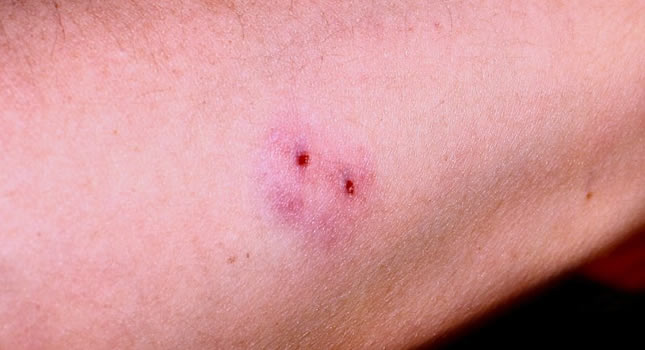In our area, there are 15 species of snakes, of which only three are poisonous - viper, adder and Orsini's viper, while the remaining 12 non-toxic and harmless.
These three venomous snakes are less toxic than eg. African or Asian snakes, such as cobras and black mamba bite and they are rarely fatal. Viper is slightly more toxic than common adder and Orsini's viper.
Bite signs:
At the site of the bite one can see two small wounds made by snake teeth. Sometimes there is only one wound. Same bite wound does not necessarily mean that the snake has injected the poison. Even at 22% of proved bites, signs of poisoning.
Signs of poisoning (not all have to be expressed):
- Dizziness
- Nausea and vomiting
- Pain and swelling at the site of the bite
- Swelling of lymph nodes in the groin after a bite in the leg or armpit after a bite in the arm.
- Shock is the most dangerous effect of the bite!
Treatment of bites:
- Bitten person has to lay still.
- Immobilize leg or arm where the bite wound. This slows the spread of toxins in the body.
- Transport the person to the hospital.
Immobilization is a procedure that the injured part of the body is placed in standby mode. Within the first aid performed temporary (transportation) immobilization. Its purpose is to prevent the worsening of the injury and reduce pain during transport to the hospital.
In sleep mode puts the bitten part of the arms or legs and two adjacent joint. The leg is immobilized in extension (the injured must lie), and arm bent at the elbow and clinging.
The most common mistakes that you should not do:
- DO NOT tie off the bitten limb.
- DO NOT cut the wound
- DO NOT suck out the poison
- DO NOT put ice on the bite.
Preventing snake bites
Some bites, such as when a person accidentally steps on a snake, it is almost impossible to prevent. However, there are precautions that can significantly reduce
the possibility that you snake bites:
- Leave the snake alone. Many people were bitten while trying to kill a snake or her as closer. Avoid tall grass if you do not have proper shoes (thick leather boots), and move the existing tracks.
- Arms and legs do not put in places that are not transparent (eg, retract your arm in a bush or behind a rock).
- Do not pick up rocks or pieces of wood if you're far enough away from potential attacks snakes. Be especially careful and alert you climb the rocks.
